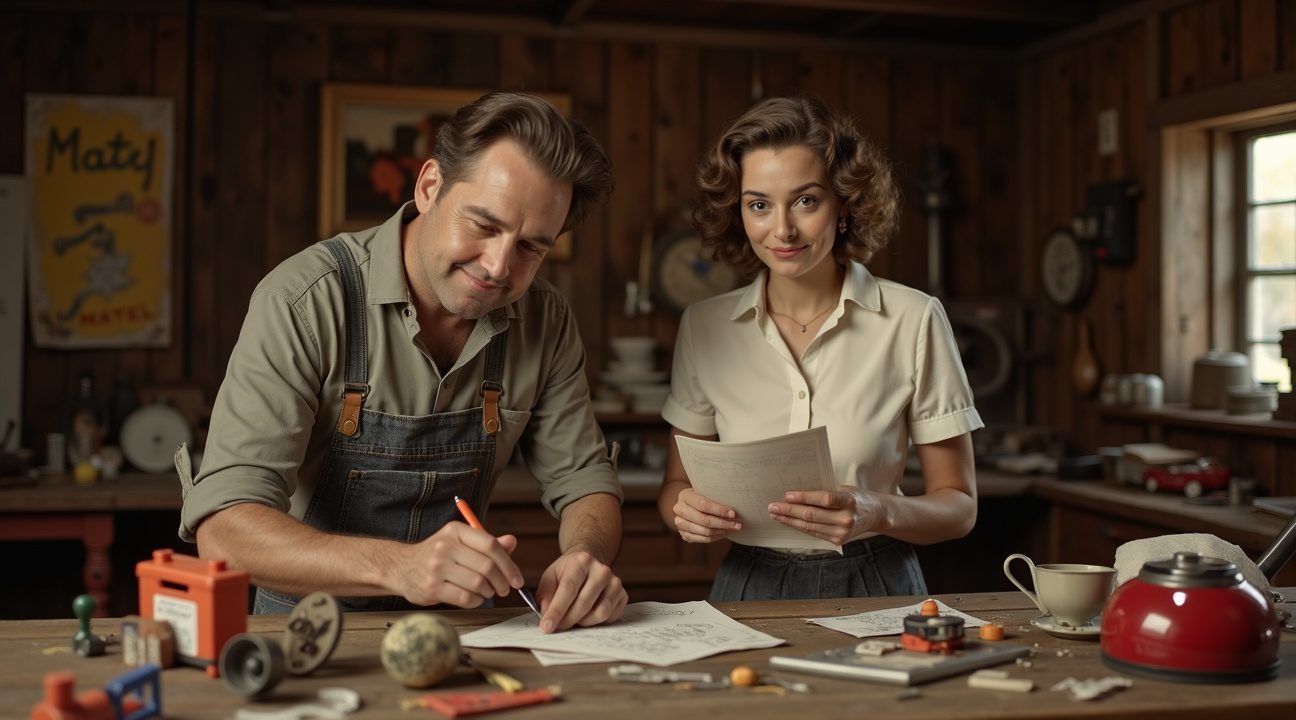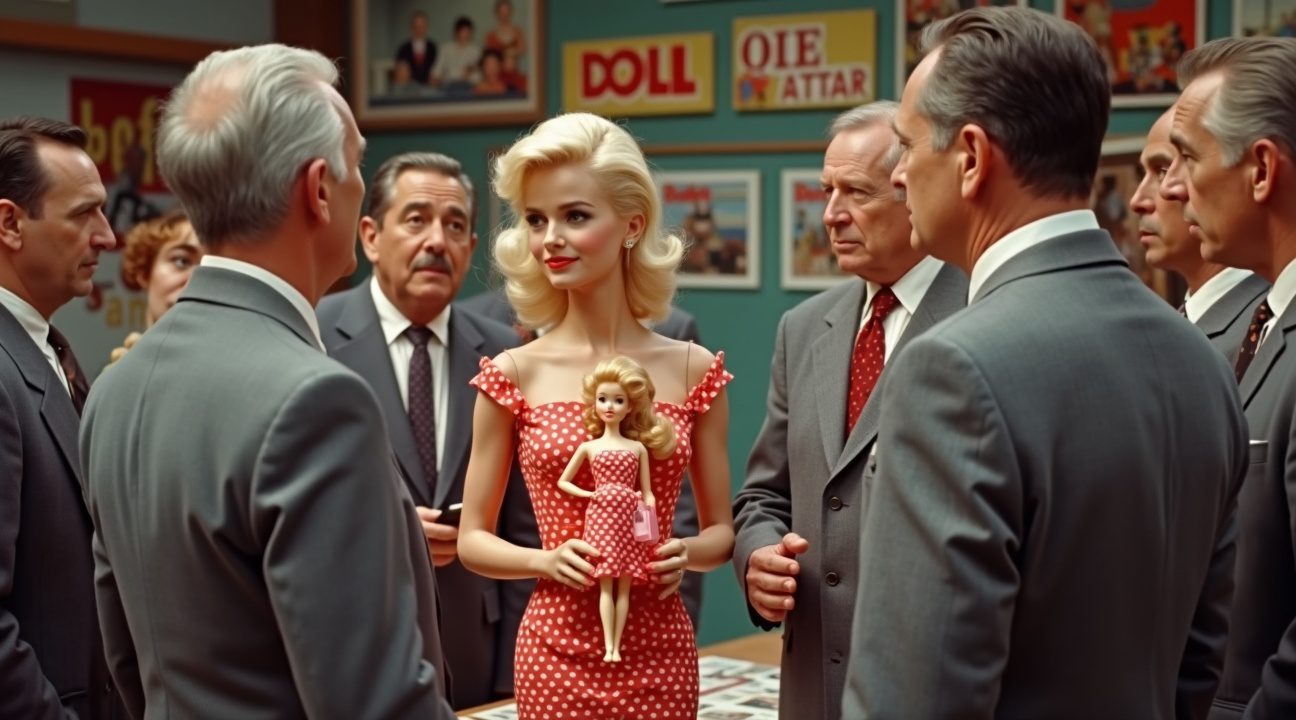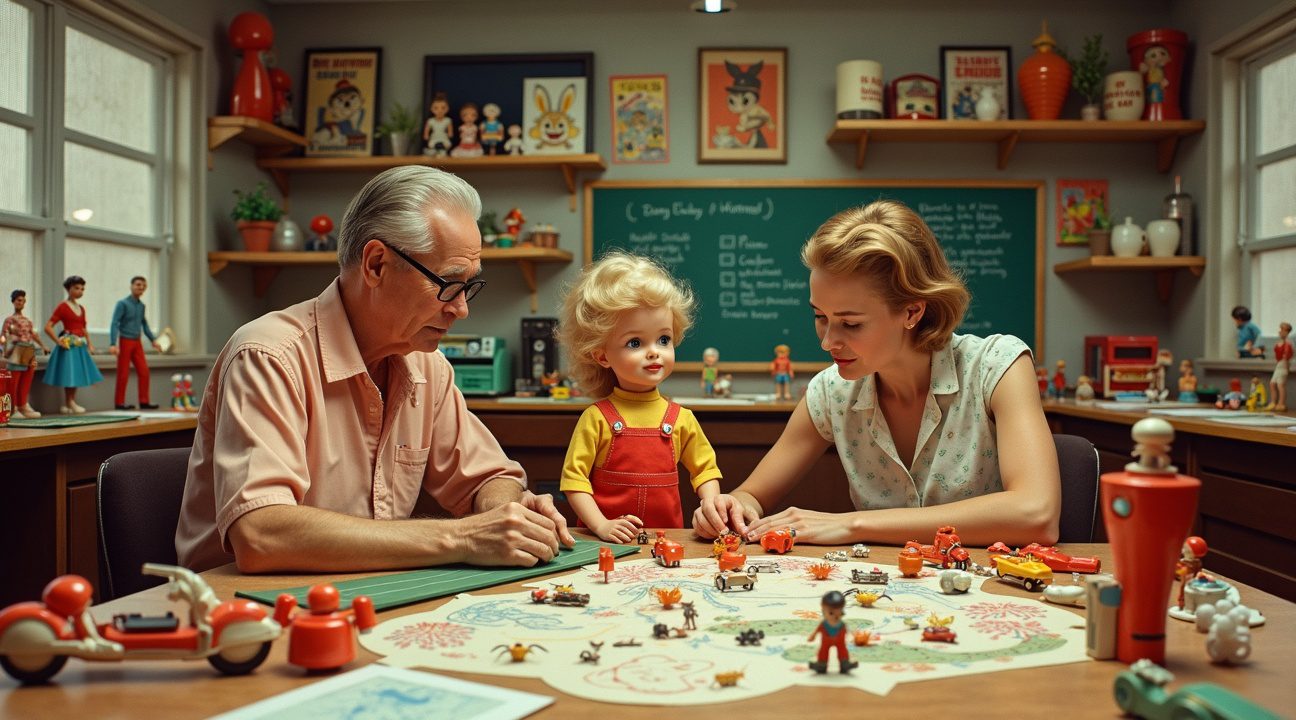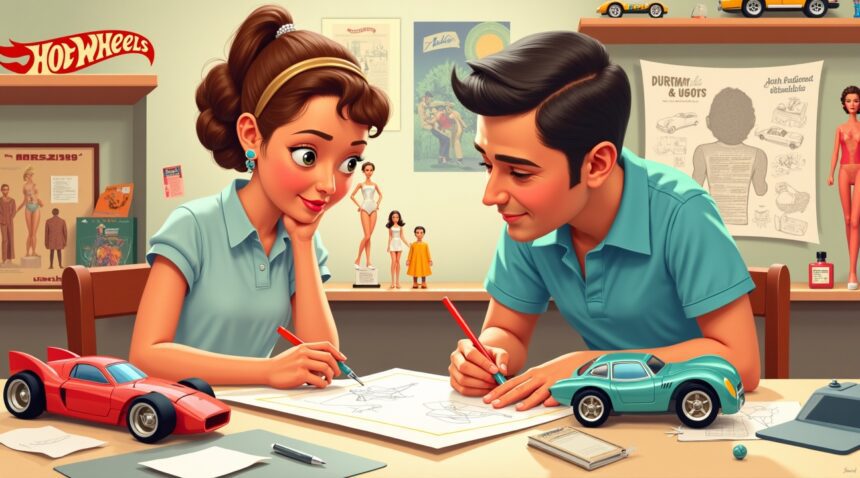The Creative Powerhouse Behind Mattel: Ruth and Elliot Handler
Ruth and Elliot Handler, the husband-and-wife team behind Mattel, created two of the most iconic toys in history through their complementary creative partnership.
Ruth Handler famously invented the revolutionary Barbie doll in 1959, while Elliot Handler brought Hot Wheels to life in 1968. Their synergy and vision propelled Mattel to the forefront of the global toy industry, transforming how generations of children play and imagine.
Key Takeaways
- Ruth Handler created Barbie after observing her daughter play with paper dolls, thereby pioneering aspirational rather than nurturing play for girls.
- Elliot Handler developed Hot Wheels by collaborating with GM designers and engineering high-speed plastic wheels for maximum performance.
- The Handlers co-founded Mattel in 1945, scaling a small workshop operation into the world’s top toy company, with Ruth leading as president for three decades.
- Both toys overcame early skepticism to become billion-dollar franchises—Barbie surpassed one billion dolls sold, while Hot Wheels boasts 10,000+ models.
- Their complementary strengths drove innovation: Ruth provided deep consumer insights, while Elliot delivered cutting-edge design and engineering solutions.
The Origins of Barbie and Hot Wheels
Observing Play and Reimagining Possibilities
Through astute observation, Ruth discovered that her daughter Barbara preferred using paper dolls to imagine adult lives, inspiring her to create a doll that encouraged future-oriented, imaginative play. This resulted in Barbie—a toy that challenged existing gender norms and created a new category in the doll industry.
Engineering Meets Entertainment
In contrast, Elliot used his engineering background and passion for cars to conceptualize Hot Wheels. His commitment to authenticity led him to work with real automotive designers, ensuring each miniature car reflected real-world counterparts in both detail and performance.
Business Strategy and Innovation
Ruth’s Marketing Foresight
Ruth was a business visionary. She expertly handled product presentations and understood how to reach customers. Notably, she pioneered direct-to-child television advertising, reshaping how toys were marketed and setting the stage for future generations of consumer targeting.
Elliot’s Manufacturing Breakthroughs
Meanwhile, Elliot’s skill in industrial design enabled Mattel to innovate in toy production. His advancements in plastic injection molding significantly reduced manufacturing costs, giving Mattel a durable competitive edge and ensuring consistent product quality at scale.
Legacy of Leadership and Impact
Identifying Gaps and Meeting Needs
The Handlers thrived by identifying unmet play needs. Barbie met the desire for aspirational role play while Hot Wheels catered to fans of speed and realism. This deliberate strategy addressed evolving child preferences and ensured enduring brand relevance.
Sustaining Relevance through Innovation
They kept their brands fresh through relentless updating—Barbie continuously embraced new careers and fashion styles, while Hot Wheels expanded into themed playsets and intricate racetracks. This approach helped both toy lines remain culturally and commercially relevant.
Enduring Influence and Industry Significance
The Power of Complementary Collaboration
Ruth and Elliot’s partnership highlights how creative and business acumen can fuse to produce extraordinary results. Their collaborative leadership emphasized innovation, user research, and market adaptability—principles that continue to influence toy industry practices worldwide.
A Blueprint for Toy Developers
Today’s toy companies still rely on the Handler approach: observe how children play, identify their aspirations, and pair that knowledge with advanced design and production techniques. The Handlers’ legacy is a powerful reminder that understanding kids’ needs and delivering engaging solutions can shape entire childhood experiences—and build billion-dollar empires.
Ruth Handler Invented Barbie While Her Husband Elliot Created Hot Wheels
I find it remarkable that two of the most iconic toys in history emerged from the creative partnership of Ruth and Elliot Handler, the husband-and-wife duo who co-founded Mattel in 1945. Ruth Handler invented the Barbie doll in 1959, naming it after her daughter Barbara, while Elliot Handler spearheaded the development of Hot Wheels, which launched in 1968 as a line of miniature die-cast toy cars.
Ruth’s vision for Barbie stemmed from watching her daughter play with paper dolls and observing how children projected adult aspirations onto their toys. The doll’s debut faced considerable skepticism from industry experts who questioned whether parents would accept a toy with adult proportions. Despite these concerns, Barbie’s launch transformed Mattel into one of the world’s leading toy companies, proving that Ruth’s understanding of children’s play patterns was spot-on.
Elliot Handler’s contribution came nearly a decade later with Hot Wheels, a project driven by his desire to create a product that would appeal to boys and balance Barbie’s overwhelming success with girls. He enlisted designers from General Motors to ensure the miniature cars reflected actual automotive design and engineering principles. This attention to authentic detail distinguished Hot Wheels from existing toy car lines and contributed to their immediate popularity.
The Strategic Balance of Two Iconic Toy Lines
The Handlers’ approach to toy development demonstrated their strategic thinking about market segmentation. Several factors contributed to their success:
- Ruth’s deep observation of children’s play behavior led to Barbie’s revolutionary design as an adult-figured doll
- Elliot’s automotive industry connections brought authentic car design expertise to Hot Wheels development
- Their combined business acumen positioned Mattel to dominate both traditionally gendered toy categories
- The timing of each launch allowed one product’s success to fund and support the other’s development
The partnership between Ruth and Elliot Handler illustrates how complementary skills and shared vision can create lasting cultural impact. Ruth’s psychological insights into children’s developmental needs paired perfectly with Elliot’s engineering background and business sense. Their collaboration at Mattel produced toys that weren’t just commercially successful but became integral parts of childhood experience for generations.
I observe that the Handlers’ story challenges assumptions about creative partnerships in business. While many successful companies emerge from partnerships between friends or colleagues, the Handler marriage brought both personal intimacy and professional collaboration to bear on product development. Barbie’s enduring appeal and Hot Wheels’ continued popularity demonstrate how their personal relationship enhanced their business innovations.
The timing of these launches also reveals the Handlers’ market intuition. Barbie arrived during the post-war economic boom when families had increased disposable income for toys, while Hot Wheels launched during the height of American car culture in the late 1960s. Both products captured not just children’s imagination but reflected broader cultural moments.
Ruth and Elliot Handler’s legacy extends beyond individual toy lines to encompass their transformation of Mattel from a small picture frame company into a toy industry giant. Their success stemmed from understanding that effective toys must engage children’s imagination while appealing to parents’ willingness to purchase. The couple’s ability to identify market gaps and fill them with innovative products established principles that continue to guide toy development today.
The Handler partnership demonstrates how creative vision, combined with business acumen and deep understanding of child development, can produce cultural phenomena that transcend their original commercial intent. Both Barbie and Hot Wheels have evolved far beyond their initial concepts, spawning movies, television shows, and collector communities that keep these brands relevant across changing generations.
How the Handlers Built Mattel From Scratch in 1945
Elliot Handler and Ruth Handler transformed a small garage workshop into one of the world’s most recognizable toy companies through their unique partnership as both spouses and business collaborators. In 1945, they co-founded Mattel alongside Harold “Matt” Matson, combining creativity with business acumen in ways that would revolutionize the toy industry.
The company’s name itself tells the story of its origins. “Mattel” emerged from blending Matson’s nickname “Matt” with Elliot’s shortened name “El.” Ruth’s name couldn’t fit into this combination, but her influence on the company would prove far more significant than any naming convention could capture.
The Early Partnership Structure
Matson’s departure in 1946 due to health issues left Ruth and Elliot as the primary forces behind Mattel’s direction. This transition proved crucial for the company’s future success, as it allowed the husband-and-wife team to fully implement their complementary vision for toy manufacturing and marketing.
Ruth Handler assumed the role of company president from 1945 to 1975, a remarkable 30-year tenure during which she guided Mattel through its transformation from startup to publicly traded corporation. Her leadership style focused on understanding market demands and positioning Mattel’s products strategically within the rapidly expanding post-war consumer economy.
Complementary Strengths Drive Innovation
The Handlers’ success stemmed from their distinctly different but perfectly complementary skill sets. Elliot brought technical expertise and inventive thinking to product development, while Ruth excelled in business management and marketing strategy. This division of labor allowed each partner to focus on their strengths while maintaining unified company direction.
Elliot’s engineering background and creative problem-solving abilities made him the ideal person to tackle manufacturing challenges and design innovations. His approach to product development emphasized both functionality and visual appeal, principles that would later prove essential in creating iconic toys. Ruth’s marketing instincts and business acumen, meanwhile, ensured that Elliot’s creations reached their target audiences effectively.
Their collaborative approach extended beyond typical husband-and-wife dynamics into genuine business partnership. Ruth didn’t simply support Elliot’s ideas; she actively shaped product direction through her understanding of consumer behavior and market trends. Her insights into what children and parents wanted often guided Elliot’s design decisions, creating a feedback loop that enhanced product development.
The company’s growth under their joint leadership was remarkable. Starting from a small operation, Mattel expanded rapidly through the 1950s and 1960s, eventually becoming large enough to go public. This growth wasn’t accidental—it resulted from the Handlers’ systematic approach to identifying market opportunities and developing products that captured children’s imaginations while appealing to parents’ sensibilities.
Their partnership model proved particularly effective because it balanced creative risk-taking with business pragmatism. Elliot could pursue innovative design concepts knowing that Ruth would evaluate their commercial viability and develop appropriate marketing strategies. Conversely, Ruth could identify market opportunities with confidence that Elliot possessed the technical skills to create products that would fulfill those needs.
The Handlers’ success story demonstrates how personal relationships can enhance business partnerships when both parties bring distinct expertise to their shared enterprise. Their innovative approach to toy design established foundations that would support Mattel’s most famous creations in the decades that followed. The combination of Elliot’s inventive spirit and Ruth’s strategic thinking created a company culture that valued both creativity and commercial success, setting the stage for breakthrough products that would define childhood play for generations.

Barbie Became a Billion-Dollar Success Despite Initial Skepticism
Ruth Handler’s revolutionary concept faced significant pushback when she first proposed creating an adult-figured doll. Industry executives couldn’t envision children wanting to play with anything other than baby dolls, yet Ruth persisted with her vision of a doll that would allow girls to imagine their future selves rather than practice motherhood.
Breaking New Ground in the Toy Industry
Barbie represented a complete departure from traditional dolls available in the 1950s. I designed the doll to inspire imaginative play focused on adult roles, giving children the opportunity to explore careers, relationships, and aspirations beyond the typical nurturing scenarios. This approach challenged conventional wisdom about what children wanted from their toys, creating an entirely new category in the process.
The original doll made its debut at the 1959 New York Toy Fair, where initial reactions were mixed at best. Many retailers expressed concerns about the doll’s mature appearance and questioned whether parents would purchase such a toy for their children. Despite these reservations, Barbie’s billion-dollar success proved that consumers were ready for this innovation.
Personal Touches That Built an Empire
The Handler family’s personal connection to the brand runs deep throughout Barbie’s development. Ruth and Elliot named their creation after their daughter Barbara, while the male companion doll Ken received his name from their son Kenneth. These personal touches helped establish an authentic foundation for what would become one of the most recognizable brands in history.
More than a billion Barbie dolls have been sold worldwide since 1959, transforming the initial skepticism into overwhelming commercial success. The doll’s ability to adapt and evolve with changing times has kept it relevant across multiple generations. From astronaut to president, veterinarian to entrepreneur, Barbie has embodied countless professions and possibilities, consistently reflecting society’s expanding views of women’s roles.
Critics and viewers alike continue to recognize Barbie’s cultural impact, extending far beyond the toy aisle into entertainment, fashion, and social commentary. The brand’s influence has permeated popular culture, inspiring everything from fashion trends to philosophical discussions about beauty standards and gender roles.
Ruth’s persistence in the face of industry resistance demonstrates how innovative thinking can overcome conventional limitations. The toy executives who initially dismissed her concept couldn’t have predicted that this single doll would generate billions in revenue and create an entire universe of products, accessories, and media content.
Barbie’s cinematic magic has proven that the brand’s appeal extends well beyond traditional toy marketing. The character’s transition from plastic figure to cultural icon showcases the enduring power of Ruth’s original vision.
The financial success of Barbie validates Ruth’s understanding of what children truly wanted from their play experiences. By creating a doll that encouraged forward-thinking rather than backward-looking play patterns, she tapped into something fundamental about human nature – the desire to dream about future possibilities.
Contemporary interpretations of the Barbie story continue to explore themes that Ruth embedded in the original concept decades ago. The brand’s ability to remain relevant while maintaining its core message speaks to the timeless nature of her innovation.
Today’s billion-dollar Barbie empire stands as testament to the power of believing in unconventional ideas. What began as one woman’s observation about her daughter’s play preferences evolved into a global phenomenon that continues to shape how children view their potential. The initial resistance Ruth encountered only makes the ultimate success more remarkable, proving that sometimes the most revolutionary ideas face the strongest opposition before achieving widespread acceptance.

Hot Wheels Revolutionized Toy Cars and Sold Billions Worldwide
Elliot Handler’s vision for Hot Wheels transformed the toy car industry when it launched in 1968, creating what would become one of the most successful toy lines in history. I can confidently say that this revolutionary product line has produced over 10,000 unique models and sold billions of cars globally, establishing an unprecedented legacy in the toy industry.
Innovative Design and Engineering Excellence
Handler’s approach to creating Hot Wheels differed dramatically from existing toy cars. He enlisted talented designers from General Motors to develop the first models, ensuring that each vehicle incorporated authentic automotive design principles and genuine engineering expertise. This collaboration brought real-world automotive knowledge into the toy industry, setting a new standard for quality and realism.
The innovative features that distinguished Hot Wheels from competitors included several key elements:
- Specialized plastic wheels designed specifically for enhanced speed and performance
- Authentic automotive styling created by professional car designers
- Precision engineering that prioritized both durability and play value
- Detailed craftsmanship that appealed to collectors and children alike
Handler strategically positioned Hot Wheels to target boys as a distinct market segment, perfectly complementing Barbie’s massive success with girls. This calculated decision created a balanced portfolio for Mattel, allowing the company to dominate both major toy demographics simultaneously.
The collaboration with real automotive designers proved instrumental in Hot Wheels’ success. These professionals brought industry expertise that elevated toy cars from simple playthings to miniature works of automotive art. Each model reflected genuine design principles, incorporating elements that car enthusiasts could appreciate while maintaining the fun factor essential for children’s play.
Hot Wheels’ impact extended far beyond traditional toy boundaries. The brand created an entire culture around collecting, racing, and automotive appreciation that continues today. Handler’s decision to prioritize speed through innovative wheel design revolutionized how children played with toy cars, introducing concepts of performance and engineering that educated while entertaining.
The massive global sales figures demonstrate Hot Wheels’ universal appeal across cultures and generations. This phenomenon mirrors how successful toy lines transcend simple entertainment to become cultural touchstones that connect families and spark imagination across decades.
Handler’s creation established manufacturing standards that influenced the entire toy industry. The combination of authentic design, innovative engineering, and strategic marketing created a formula that competitors struggled to replicate, securing Hot Wheels’ position as the definitive toy car brand worldwide.
The Handlers Created Multiple Toy Industry Milestones Beyond Their Famous Brands
The Handlers’ creative genius extended far beyond Barbie and Hot Wheels, establishing them as true innovators who revolutionized the entire toy industry. Their company, Mattel, became a breeding ground for groundbreaking products that would define childhood experiences for generations.
Revolutionary Product Development
Elliot Handler’s invention of Chatty Cathy marked another pivotal moment in toy history as the first talking doll to capture mass market appeal. This innovative creation demonstrated the couple’s commitment to pushing technological boundaries in toy design. The doll’s ability to speak various phrases fascinated children and parents alike, setting a new standard for interactive play.
Mattel’s product portfolio under the Handlers’ leadership expanded into numerous successful lines that showcased their diverse creative vision:
- Creepy Crawlers allowed children to create their own rubber creatures using heat and molds
- Liddle Kiddles featured tiny dolls with intricate details and accessories
- Various action figures and games that appealed to different age groups and interests
- Educational toys that combined learning with entertainment
These diverse offerings reflected the Handlers’ understanding that children’s play needs varied significantly across different demographics and developmental stages.
Industry Leadership and Innovation
The couple’s strategic vision transformed Mattel into the world’s largest toy manufacturer by revenue, a position that reflected their exceptional business acumen and product development skills. Their leadership style emphasized both creative innovation and smart business practices, creating a company culture that consistently produced hit products.
Mattel pioneered licensing agreements that would become standard practice throughout the industry. The company’s partnerships with major entertainment properties like Bugs Bunny and DC Comics opened new revenue streams while introducing beloved characters to toy form. These deals demonstrated the Handlers’ early recognition that cross-media marketing could significantly amplify a product’s reach and appeal.
Ruth and Elliot Handler are frequently cited as among the most influential figures in 20th-century toy history, and their impact extends well beyond individual product success. They fundamentally changed how toys were designed, marketed, and distributed. Their approach to gender-targeted marketing, while sometimes controversial in modern discussions, reflected a sophisticated understanding of how different children engaged with play.
The couple’s international brand-building strategies established Mattel as a global presence, making their toys accessible to children worldwide. This expansion required adapting products for different cultural contexts while maintaining the core appeal that made them successful in American markets. Their success in international markets laid the groundwork for the modern global toy industry.
Barbie’s enduring cultural impact represents just one example of how the Handlers’ creations transcended simple toy categories to become cultural phenomena. Their ability to create products that remained relevant across decades speaks to their deep understanding of both child psychology and market dynamics.
The Handlers’ influence on toy design philosophy continues to shape how manufacturers approach product development today. They proved that toys could be more than simple playthings by creating products that sparked imagination, encouraged role-playing, and provided educational value. Their legacy lives on in every talking toy, every detailed miniature, and every product that successfully bridges entertainment and learning.
Their comprehensive approach to building a toy empire encompassed everything from initial concept development to global distribution strategies. This holistic vision made Mattel a dominant force that continues to influence how toys are created and marketed decades after the Handlers stepped away from daily operations.

Barbie and Hot Wheels Remain Cultural Icons Across Generations
Mattel’s powerhouse brands continue to dominate toy aisles worldwide, proving that Ruth and Elliot Handler’s creative vision extends far beyond their original concepts. Barbie’s billion-dollar success demonstrates how the fashion doll has transcended her plastic origins to become a global phenomenon that resonates with collectors, children, and adults alike.
Entertainment and Media Dominance
Hot Wheels and Barbie have successfully expanded into major entertainment franchises that captivate audiences across multiple platforms. The brands have spawned countless animated series, video games, and streaming content that keeps them relevant in today’s digital landscape. Barbie’s recent cinematic triumph showcased how these classic toys can be reimagined for contemporary audiences while maintaining their core appeal.
Hot Wheels has carved out its own entertainment niche through racing competitions, stunt performances, and interactive experiences that bring the miniature cars to life. The brand’s presence in motorsports and gaming communities has created dedicated fan bases that span generations, proving that small-scale racing can generate full-scale excitement.
Strategic Collaborations and Market Evolution
Both brands demonstrate remarkable adaptability through strategic partnerships that keep them culturally relevant.
- Hot Wheels collaborations with premium brands like Nike create limited-edition collectibles that appeal to adult enthusiasts and sneaker culture alike. These partnerships bridge the gap between childhood nostalgia and contemporary fashion trends.
- The collectibles market has become a significant revenue driver, with rare and vintage pieces commanding impressive prices among dedicated collectors.
- Limited editions, special releases, and anniversary collections create ongoing demand that extends well beyond traditional toy purchasing patterns.
This collector enthusiasm ensures that both brands maintain strong secondary markets that reinforce their cultural value.
Barbie continues to evolve through diverse representation, career-focused dolls, and collaborations with high-fashion designers that elevate the brand’s sophistication. The doll’s cinematic magic has proven that she can successfully transition between childhood play and adult entertainment without losing her essential identity.
Hot Wheels maintains its edge through constant innovation in track design, car models, and racing experiences. The brand’s ability to capture real automotive trends while creating fantastical designs keeps it appealing to car enthusiasts of all ages. Global competitions and collector events create communities that celebrate the brand’s racing heritage while fostering new generations of fans.
The merchandising reach of both brands extends into fashion, home goods, electronics, and lifestyle products that allow fans to integrate their favorite childhood brands into adult life. Celebrity endorsements and cultural moments keep both brands in mainstream conversations, ensuring they remain part of popular culture discussions.
Technology integration has allowed both brands to embrace digital play experiences while maintaining their physical toy foundations.
- Augmented reality features
- Mobile apps
- Interactive experiences
These innovations create hybrid play patterns that appeal to tech-savvy children while respecting traditional play values.
The Handlers’ innovative approach to toy design and marketing established principles that continue to guide both brands today. Their understanding that toys could serve as vehicles for imagination, aspiration, and self-expression created frameworks that remain relevant across changing cultural landscapes. Modern interpretations of these classic brands demonstrate how timeless concepts can be refreshed for new audiences without losing their fundamental appeal.
The cross-generational impact of these brands creates unique family bonding opportunities where parents share childhood favorites with their children. This cyclical pattern ensures consistent market presence while building emotional connections that transcend simple toy ownership. Recent cultural phenomena have reinforced how these brands can capture mainstream attention and generate widespread cultural conversations that extend far beyond toy industry boundaries.
Sources:
Wikipedia – “Elliot Handler”
Wikipedia – “Mattel”
Britannica Money – “Mattel Inc.”
We Are The Mighty – “Mattel World War II Veteran”
Shoe Palace Blog – “The Story of Hot Wheels”
Toy Museum (via Threads)


